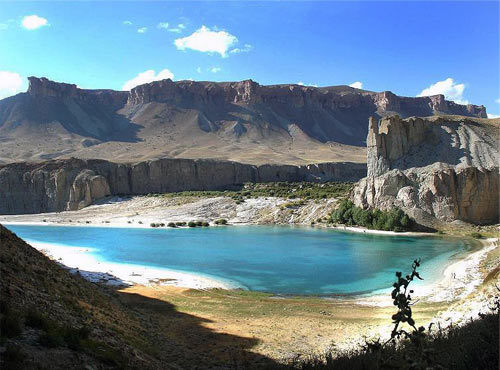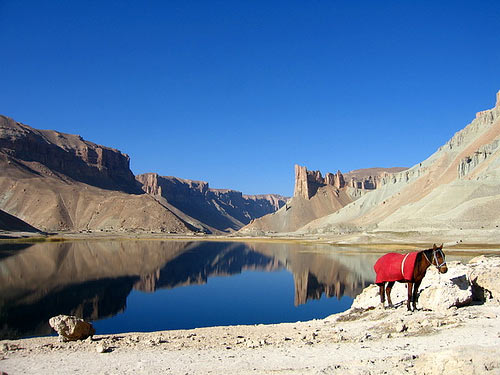
Water Resources Management in Afghanistan: The Issues and Options
Water Resources Management Issues
Afghanistan is predominantly an agrarian society with 80 percent of the population living in rural areas, and directly dependent on natural resources for livelihoods (small scale farming, pastures and forest products). Since rainfall is scanty and highly variable over most of the country where topography and soils are suitable for agriculture, there are few areas where rainfed crops can provide a reliable basis for livelihoods. The surveys of 1978 have indicated that 80 percent of wheat and 85 percent of all crops were produced on irrigated lands. This is also reported to be true for the present day situation. Hence the evolution and growth of agriculture and food security in Afghanistan is very much dependent on the development of irrigation.

Water resources management in Afghanistan is primarily irrigation water management because at present the annual water used for irrigation is about 99% of the all water used. Nearly 90 percent of all irrigation systems in Afghanistan, covering about 2.3 million ha, are traditional schemes developed and built by farmers and operated and maintained by them according to traditional communal customs and practices. Total developed irrigated area in 1978 was estimated to be 2.63 million ha of which only 1.44 million ha had sufficient water supply to support double cropping in a year (FAO, 1997).
The effects of war and neglect on these systems have not been systematically assessed. However, according to FAO estimates of 1997, about 1.7 million ha required rehabilitation, and another 0.68 million ha required improved on-farm water management conditions. Canal management has completely collapsed. Canals are completely silted, breached, and not delivering as in the past. About 46% of the irrigation structures are damaged and 88% of the irrigation structures are traditional which are responsible for the 40% of the total water loss. For example, irrigation provided under the Parwan project declined from 25,000 ha to 10,000 ha due to sedimentation in canals and poor maintenance. Similarly, irrigated land declined sharply since 1978, from 2.8 million ha to about 1.2 million ha. This is primarily due to drought and lack of maintenance of surface water facilities-small dams and canal systems.
The indirect impact of war on modern irrigation systems is much more serious than the traditional schemes. The intake structures of modern irrigation schemes are out of function due to the missing of mechanical parts looted during the war and lack of professional staff to repair and operate these systems. However, the direct negative impact of war on irrigation infrastructure was less a consequence of destruction but much more a consequence of the migration of farmers to other countries leaving behind the irrigation schemes unattended. Farmers have abandoned about 40% of the land due to lack of maintenance and 10% of the land is completely destroyed due to war. About one half of all irrigation schemes are in need of rehabilitation.
Surface water irrigation systems are performing less than half of the 1980 levels. As a result, irrigated area has drastically reduced. Estimates of the irrigation department indicate that currently only 1.4 million hectares are being irrigated, which is half that of 1980 levels. This has resulted in an estimated overall national food deficit of 30 per cent.
Afghan farmers use centuries old farming techniques with oxen providing the draught power. While agriculture is the basis of economy little knowledge on new irrigation technologies and cultural practices is available to the farmers, and institutional credit facilities are almost absent. As a result, irrigation system efficiencies are rated to 25-30 percent and productivity levels are low even by regional standards. About 20 percent of all irrigation systems require improvement of on-farm water management to avoid under-irrigation (low crop yields) or over-irrigation (water logging and salinization). By promoting technology transfer, production potential of these lands can be improved substantially even under low and variable rainfall regimes.
Afghanistan has an annual potential of about 20 BCM of groundwater out of which only 3 BCM is in use. It is expected that due to irrigation and water supply demand, groundwater use in future will increase to 8 BCM. Due to continuous drought of last four years, all traditional groundwater irrigation systems have reduced in capacity or dried up completely. About 60% of the karezes are not in use and 85% of the shallow wells are dried out. Boring of deep wells close to karezes and shallow wells had an adverse effect on the production of these traditional irrigation systems. This has threatened the sustainability of these traditional systems in the long run.
In most of rural areas local population is dependent on groundwater for drinking and domestic supplies. Over-exploitation of groundwater has resulted in water table decline in most of the areas. As the water table continues to fall, around 0.5 to 3 m each month depending to the place, the poorer families are unable to dig their wells deeper and thus are forced to get water from communal wells. Many of these wells, often located in the mosques, have either already dried up, forcing people (often children) to walk long distances to meet their daily water needs. In addition, billions of dollars of investment made earlier in providing these facilities would be wasted.
Community infrastructure related to agricultural production, such as irrigation systems and water impoundments, bridges and roads are badly damaged. Participation of local communities (particularly women) in decision making for economic development has been poorly focused although community based approach for development has traditional foundations in Afghanistan. The possibilities of installing old mirab/vakil system of water distribution among the farming community are very low. These circumstances made and still make it difficult to rehabilitate large traditional irrigation schemes.
Currently, very few skilled professionals are available in the country to undertake the development programs. This requires an urgent strategy to address the anticipated shortfall. While improving capacity, it is essential that specific strategies are developed to support and improve the involvement of women both in Governmental institutes and in the rural communities.
The absence of coherent government over many years has led to the involuntary withdrawal of line ministries from their traditional roles at national and provincial levels. Presently, there is no institution capable or authorized to monitor groundwater extraction or surface water use; there is virtually no water resources management taking place at present. There are five ministries who are directly involved in the management of water resources in Afghanistan. Ministry of Rural Development and Reconstruction, Ministry of Irrigation, Ministry of Mining, Ministry of Agriculture, Ministry of Public Works, and Ministry of Power.
The Ministry of Rural Development deals with minor irrigation, water supply, and sanitation projects in rural areas. The Ministry of Irrigation deals with major irrigation infrastructure of the country. They are in charge of planning, building, and maintaining major water storage and water conveyance facilities. The Ministry of Mining is responsible for groundwater resources of the country. The Ministry of Public Works, through its Water Supply Authority is responsible for water supply for major cities in the country. Presently, all these ministries lack coordination, which is affecting the effective water resources management.

Source: Water Resources Management in Afghanistan: The Issues and Options by Asad Sarwar Qureshi, IWMI, Working Paper 49
